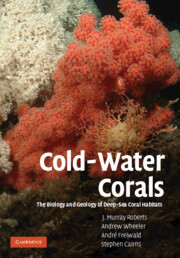1 - History and research approaches
Published online by Cambridge University Press: 23 December 2009
Summary
To most people corals are synonymous with the bright, well-lit waters of tropical coral reefs. Yet in fact the majority of corals inhabit deep, cold waters across a diverse range of marine environments from inland fjords to the continental shelf, slope, offshore banks, seamounts and even the abyssal plain. While we have known about these cold-water corals for hundreds, or even thousands, of years it is only in the last ten years that research into the biology of the corals themselves, the ecology of the habitats they provide and the geology of the structures they form has gathered pace. Cold-water coral habitats are biodiversity rich. Recent work has revealed them as unique palaeoceanographic archives. Sadly all too many surveys have shown they have been damaged by human activity. In this book we have tried to summarise the many, varied and exciting developments in our understanding of cold-water corals. Research effort on cold-water corals is now increasing exponentially around the world and it has been challenging to compress this body of work into the pages of one book. Before we consider cold-water corals and some of these recent findings in more detail we begin with a brief historical summary and an outline of the research approaches used to study cold-water corals.
History
Early history and taxonomy
The history of modern research on cold-water corals goes back to the late eighteenth century.
- Type
- Chapter
- Information
- Cold-Water CoralsThe Biology and Geology of Deep-Sea Coral Habitats, pp. 1 - 19Publisher: Cambridge University PressPrint publication year: 2009

